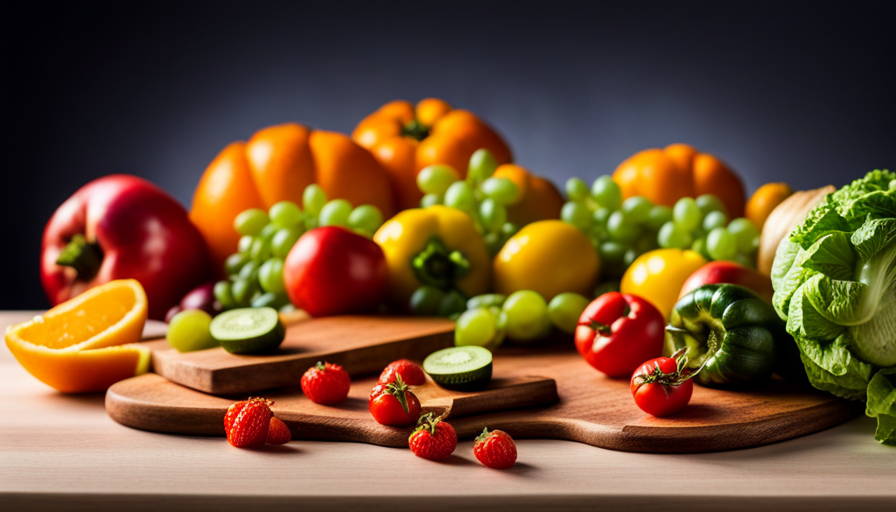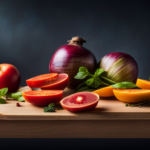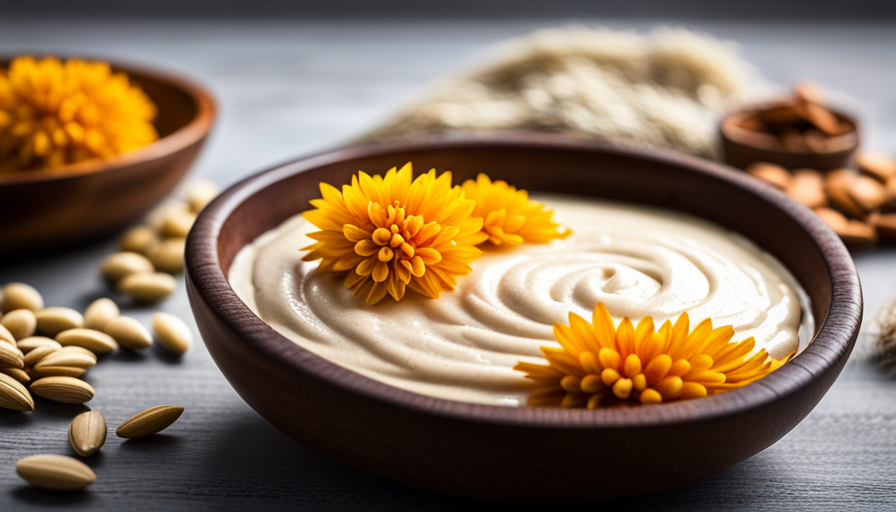As I get older, I frequently take time to think about the decisions I’ve made over the course of my life, particularly when it comes to my health and wellness. One topic that has consistently intrigued me is the influence of food on our physical well-being.
Recently, I’ve been exploring the benefits of incorporating more raw food into my diet, and let me tell you, the results have been nothing short of remarkable.
In this article, we will delve into the world of raw food and uncover the incredible nutritional benefits it offers, not only for older adults like myself but for people of all ages. We will explore how raw food can boost energy levels, support weight management, and promote overall health and well-being.
I will also share some practical tips on how to incorporate more raw food into your daily routine, as well as address common concerns and misconceptions around this lifestyle choice.
So, join me on this journey as we discover the transformative power of raw food and how it can help us thrive in our golden years. Get ready to unlock a whole new level of vitality and embrace a healthier, more vibrant life.
Key Takeaways
- Raw food can support healthy aging and digestion in older individuals.
- Including raw foods in the diet can enhance nutrient absorption and bowel movements.
- Raw food is rich in vitamins, minerals, and antioxidants, which can protect against age-related diseases.
- Consuming raw food can help manage menopause symptoms and maintain bone health in older individuals.
The Nutritional Benefits of Raw Food
As you age, incorporating raw food into your diet can provide you with a wealth of essential nutrients and enzymes that are often lost during the cooking process. Raw food, such as fruits, vegetables, and nuts, is packed with vitamins, minerals, and antioxidants that are beneficial for your overall health.
One of the key benefits of raw food is its ability to boost brain health. Studies have shown that certain raw foods, like blueberries and spinach, contain high levels of antioxidants that can help protect the brain from oxidative stress and improve cognitive function.
Additionally, raw food is also known for promoting healthy skin. The vitamins and minerals found in raw fruits and vegetables, such as vitamin C and beta-carotene, can help nourish and rejuvenate the skin, giving it a youthful and glowing appearance.
Incorporating raw food into your diet can also help boost energy and vitality. Raw food is easier to digest compared to cooked food, allowing your body to absorb nutrients more efficiently. This can result in increased energy levels and improved overall well-being.
So, if you want to reap the benefits of boosting brain health and promoting healthy skin, consider adding more raw food to your diet.
Boosting Energy and Vitality
When it comes to boosting energy and vitality, raw food can play a crucial role. One key benefit is increased nutrient absorption, as raw foods are rich in vitamins, minerals, and enzymes that are easily absorbed by the body.
Additionally, raw food supports healthy aging by providing antioxidants and phytochemicals that help fight oxidative stress and inflammation.
Lastly, raw food can improve digestion and gut health, as it contains fiber and natural enzymes that aid in the breakdown and assimilation of nutrients.
Increased Nutrient Absorption
By incorporating raw foods into your diet as you age, your body becomes a nutrient-absorbing powerhouse, maximizing the benefits of every bite.
Raw foods are rich in enzymes, which help in breaking down food and making it easier for the body to absorb nutrients. This increased nutrient absorption is especially beneficial for older adults, as they may have decreased digestive function.
Raw foods also contain fiber, which supports digestive health by promoting regular bowel movements and preventing constipation.
Additionally, raw foods are packed with vitamins, minerals, and antioxidants that can boost overall health and support healthy aging. These nutrients help protect against age-related diseases and promote optimal functioning of the body.
By embracing raw foods, you can enhance your nutrient absorption and lay a strong foundation for healthy aging.
Support for Healthy Aging
To age gracefully, it’s important to embrace a diet that nourishes your body from the inside out, supporting overall health and well-being. One way to achieve this is by incorporating raw food into your meals. Raw food is packed with essential nutrients, enzymes, and antioxidants that can provide significant support for healthy aging.
The benefits of raw food include improved digestion, increased nutrient absorption, and reduced inflammation. Raw fruits and vegetables are rich in vitamins, minerals, and fiber, which can help maintain a healthy weight, support cardiovascular health, and boost the immune system. Additionally, the antioxidants found in raw food can help protect against cellular damage and oxidative stress, which are associated with aging.
By incorporating raw food into your diet, you can nourish your body and support healthy aging. As we age, it becomes increasingly important to focus on improved digestion and gut health.
Improved Digestion and Gut Health
Incorporating a variety of nutrient-rich, enzyme-packed foods into my diet has led to improved digestion and a healthier gut.
Raw foods, such as fruits, vegetables, and sprouts, are rich in digestive enzymes that help break down food and improve nutrient absorption. These enzymes aid in the digestion of proteins, carbohydrates, and fats, leading to smoother digestion and reduced bloating.
Additionally, raw foods contain fiber, which promotes regular bowel movements and supports a healthy gut flora. By nourishing my body with raw foods, I’ve noticed a decrease in digestive issues and an increase in energy levels.
Moving forward, managing weight and metabolism can also be influenced by the incorporation of raw food into my diet.
Managing Weight and Metabolism
Maintaining a healthy weight and a fast metabolism becomes a deliciously effortless task with the help of raw food. As we age, our metabolism tends to slow down, making it more challenging to manage our weight. However, incorporating raw food into our diet can help boost our metabolism and support weight management.
Raw foods are rich in nutrients and low in calories, making them a great choice for those looking to shed pounds. They’re also high in fiber, which helps keep you feeling full and satisfied for longer periods. This can prevent overeating and promote weight loss.
Additionally, raw foods are often less processed than cooked foods, so they retain more of their natural enzymes that aid in digestion and metabolism.
In addition to weight management, raw food can also play a crucial role in managing menopause symptoms and maintaining bone health. Certain raw foods, such as flaxseeds and soy, contain phytoestrogens that mimic the effects of estrogen in the body. This can help alleviate symptoms like hot flashes and night sweats. Raw foods are also rich in calcium and other nutrients necessary for maintaining strong and healthy bones.
By incorporating raw food into our diet, we can support our overall health and well-being. Raw food provides us with an abundance of vitamins, minerals, and antioxidants that help boost our immune system and protect against disease. So, whether you’re looking to manage your weight, support your bones, or simply improve your overall health, raw food is a delicious and nutritious option to consider.
Supporting Overall Health and Well-being
Reducing inflammation, enhancing immune function, and lowering the risk of chronic diseases are all important aspects of supporting overall health and well-being. By incorporating a diet rich in raw foods, I’ve noticed a significant decrease in inflammation throughout my body, leading to improved comfort and mobility.
Additionally, the high levels of vitamins, minerals, and antioxidants found in raw foods have strengthened my immune system, helping me to fend off illnesses more effectively.
Finally, the abundance of fiber and phytonutrients in raw foods has been shown to reduce the risk of chronic diseases such as heart disease, diabetes, and certain types of cancer, providing long-term health benefits.
Reduced Inflammation
By including more raw food in your diet, you can experience a significant decrease in inflammation as you age. Studies have shown that a diet rich in raw fruits, vegetables, and nuts can help reduce markers of inflammation in the body. Inflammation is a natural response to injury or infection, but chronic inflammation can contribute to the development of various age-related diseases, such as heart disease, diabetes, and arthritis. Raw foods are packed with antioxidants, vitamins, and minerals that help combat inflammation and support overall health. For example, fruits like berries and oranges are high in vitamin C, which has anti-inflammatory properties. Leafy greens like spinach and kale are rich in antioxidants that help reduce inflammation. Incorporating raw food into your diet can be as simple as adding a side salad or a piece of fresh fruit to your meals. By reducing inflammation, you can support your overall well-being and enjoy a healthier life as you age. Transitioning to the next section, focusing on enhanced immune function, is crucial for maintaining optimal health.
Enhanced Immune Function
Boosting your immune system can be as simple as incorporating more nutrient-rich, vibrant foods into your daily meals. As we age, our immune system naturally weakens, making us more susceptible to infections and diseases. However, research has shown that consuming raw foods can enhance our immune function and help slow down the aging process.
Raw foods, such as fruits, vegetables, and nuts, are packed with vitamins, minerals, and antioxidants that support our immune system and protect against harmful free radicals. These nutrients help strengthen our body’s defense mechanisms and promote the production of immune cells.
By including raw foods in our diet, we can give our immune system the boost it needs to fight off illnesses and maintain optimal health as we get older.
Transitioning into the subsequent section about ‘lowered risk of chronic diseases’, we can also reduce our risk of developing chronic conditions by incorporating more raw foods into our diet.
Lowered Risk of Chronic Diseases
Enhance your overall health and decrease the likelihood of developing chronic diseases by incorporating nutrient-rich, vibrant foods into your daily meals. Consuming raw food has long-term effects that can benefit us as we age gracefully.
Raw food is packed with essential nutrients, enzymes, and antioxidants that can support our immune system, improve digestion, and reduce inflammation. These factors play a crucial role in preventing chronic diseases such as heart disease, diabetes, and certain types of cancer.
Studies have shown that a diet rich in raw fruits, vegetables, nuts, and seeds can lower the risk of these conditions and promote longevity.
To learn more about incorporating more raw food into your diet, check out the subsequent section for helpful tips and ideas.
Tips for Incorporating More Raw Food into Your Diet
Try incorporating a greater amount of uncooked, nutrient-rich foods into your daily meals to optimize your health and well-being as you age gracefully. One way to do this is by exploring raw food recipes that aren’t just delicious but also packed with essential vitamins and minerals.
From refreshing salads to vibrant smoothies, there are countless options to choose from. Additionally, incorporating raw food snacks into your diet can be a great way to increase your intake of raw foods. You can try snacking on raw nuts, fresh fruits, or even homemade energy bars made from raw ingredients.
Adding more raw food to your diet can provide numerous health benefits. Raw foods are rich in enzymes, which can aid in digestion and promote a healthy gut. They’re also high in antioxidants, which help protect against oxidative stress and reduce the risk of chronic diseases. Furthermore, raw foods are often lower in calories and higher in fiber compared to their cooked counterparts, making them a great choice for weight management.
To ensure food safety and hygiene when incorporating raw foods into your diet, it’s important to thoroughly wash all fruits and vegetables before consuming them. Additionally, make sure to store raw foods properly to prevent contamination and spoilage. By following these guidelines, you can safely enjoy the benefits of incorporating more raw food into your diet and continue on your journey to optimal health and well-being.
Ensuring Food Safety and Hygiene
To maintain the freshness and cleanliness of your meals, it’s crucial to prioritize food safety and hygiene when incorporating a greater amount of uncooked, nutrient-rich ingredients into your diet.
Here are some important food safety and hygiene practices to keep in mind:
-
Wash your hands: Before handling any raw food, make sure to thoroughly wash your hands with soap and warm water for at least 20 seconds. This helps to eliminate any potential bacteria or contaminants.
-
Clean your produce: Rinse your fruits and vegetables under running water to remove any dirt, pesticides, or bacteria. Use a brush to scrub firm produce like melons or potatoes.
-
Separate cutting boards: Use separate cutting boards for raw meats and other raw ingredients to avoid cross-contamination. This prevents the spread of harmful bacteria.
-
Store properly: Store raw food in sealed containers in the refrigerator to prevent the growth of bacteria. Ensure that raw meats are stored separately from other foods to prevent any potential contamination.
By following these food safety and hygiene practices, you can enjoy the benefits of incorporating more raw food into your diet while minimizing the risk of foodborne illnesses.
In the next section, we will discuss raw food preparation techniques and tools.
Raw Food Preparation Techniques and Tools
Get creative in the kitchen with raw food by exploring different techniques and tools that can unlock a whole new world of culinary possibilities. When it comes to preparing raw food, there are several methods that can help preserve its freshness and nutritional value.
One popular method is dehydration, which involves removing the moisture from fruits, vegetables, and herbs to extend their shelf life. Dehydrators are handy tools that can be used to achieve this, allowing you to make delicious dried snacks like kale chips or dried fruit slices.
Another technique is fermentation, which not only enhances the flavor of raw food but also promotes the growth of beneficial bacteria. Fermented foods like sauerkraut and kimchi are rich in probiotics, which can support gut health. To make fermented raw food, you’ll need fermentation jars or crocks, which provide an airtight environment for the fermentation process to occur.
In addition to these preservation methods, there are endless raw food recipe ideas to explore. From zucchini noodles to raw chocolate mousse, the possibilities are endless. By using tools like spiralizers, mandolines, and high-speed blenders, you can easily transform raw fruits and vegetables into delicious and nutritious meals.
Now that we’ve covered the various raw food preparation techniques and tools, let’s address common concerns and misconceptions about using raw food when you’re older.
Addressing Common Concerns and Misconceptions
When it comes to raw food preparation, there are common concerns and misconceptions that need to be addressed.
First, protein and nutrient adequacy is a key concern for many people considering a raw food diet. However, it’s important to note that there are plenty of plant-based sources of protein and other essential nutrients that can be included in a raw food diet.
Secondly, digestive issues may arise when transitioning to a raw food diet, but these can often be managed by gradually introducing raw foods into your diet and listening to your body’s needs.
Lastly, finding a balance between raw and cooked foods is important for a well-rounded diet, as cooking can enhance the availability of certain nutrients while raw foods provide enzymes and other beneficial compounds.
Protein and Nutrient Adequacy
As I age, ensuring adequate protein and nutrient intake becomes crucial for maintaining optimal health and well-being. Protein deficiencies and nutrient deficiencies can lead to a variety of health problems, including muscle loss, weakened immune system, and decreased cognitive function.
Raw food can be an excellent source of protein and essential nutrients. It contains enzymes and vitamins that are often destroyed during cooking, making it easier for our bodies to absorb and utilize these nutrients. Additionally, raw food is rich in fiber, which aids in digestion and promotes a healthy gut.
However, it’s important to note that some individuals may experience digestive issues when transitioning to a raw food diet. These issues can be addressed by gradually introducing raw foods into the diet and ensuring a balanced intake of nutrients.
Digestive Issues and Raw Food
Transitioning to a raw food diet can bring about unexpected digestive challenges, leaving you feeling frustrated and discouraged. While raw food can be rich in fiber and enzymes that support digestion, it can also be difficult for some individuals to tolerate.
Dietary restrictions are often necessary when following a raw food diet, as certain foods may exacerbate digestive issues. Additionally, it’s important to consider raw food and medication interactions, as some medications may require specific dietary guidelines. It’s crucial to consult with a healthcare professional before making any drastic changes to your diet, especially if you’re on medication.
In the next section, we’ll explore the concept of balancing raw food with cooked food, which can help alleviate digestive issues and ensure a well-rounded diet.
Balancing Raw Food with Cooked Food
To achieve a well-rounded diet, it’s important to find a balance between consuming raw and cooked foods. This balance can help alleviate digestive issues and provide optimal nutrition.
Did you know that, according to a study, incorporating a variety of cooked vegetables into your diet can increase the absorption of certain nutrients by up to 50%? While raw food has its benefits, such as preserving enzymes and nutrients, cooking certain foods can make them easier to digest and unlock additional nutrients.
Raw food can be tough on the digestive system, especially for older individuals who may already have digestive issues. Finding the right balance between raw and cooked foods is key to maintaining optimal health.
Seeking professional guidance and support can further enhance your understanding of how to achieve this balance.
Seeking Professional Guidance and Support
Seeking professional guidance and support can be incredibly beneficial when incorporating raw food into your diet as you age. With the help of professional advice, you can ensure that you are following a personalized approach that meets your specific nutritional needs.
One of the key advantages of seeking professional guidance is that you can receive expert advice tailored to your individual circumstances. A healthcare professional or registered dietitian can assess your current health status, consider any medical conditions or medications you may be taking, and provide recommendations that are suitable for you. They can also help you create a balanced meal plan that includes both raw and cooked foods, ensuring that you are getting all the necessary nutrients for optimal health.
To make it easier for you to understand the benefits of seeking professional guidance, here is a table showcasing the advantages:
| Advantages of Seeking Professional Guidance |
|---|
| Personalized approach |
| Expert advice |
| Consideration of health status |
| Balanced meal planning |
| Optimal nutrient intake |
Seeking professional guidance and support when incorporating raw food into your diet as you age can provide you with the knowledge and guidance needed to ensure a healthy and balanced approach. By working with a professional, you can create a personalized plan that meets your unique needs.
Conclusion and Final Thoughts
If you’re ready to embark on the journey of embracing a more vibrant and youthful lifestyle, why not consider tapping into the wisdom of professionals who can help guide you towards a future brimming with vitality and wellbeing? Seeking professional guidance and support when incorporating raw food into your diet, especially as you age, can be crucial to ensuring food safety and navigating dietary restrictions.
As we get older, our bodies may become more susceptible to foodborne illnesses. Raw food, while packed with nutrients, can also carry potential risks if not handled properly. Professionals in the field of nutrition and dietetics can provide valuable insights on how to safely handle, prepare, and store raw food to minimize the risk of contamination and maximize its health benefits.
Additionally, dietary restrictions may become more prevalent as we age, whether due to medical conditions or personal choices. Professionals can help tailor a raw food diet that meets your specific needs and ensures that you’re getting all the necessary nutrients. They can also provide information on potential interactions between raw food and medications, helping you make informed decisions about your health.
Seeking professional guidance and support when incorporating raw food into your diet as you age is essential for food safety and meeting dietary restrictions. By consulting with experts in the field, you can embark on a journey towards a more vibrant and youthful lifestyle, while ensuring your health and wellbeing are prioritized.
Frequently Asked Questions
Can raw food help prevent age-related diseases such as heart disease and diabetes?
Raw food can indeed help prevent age-related diseases such as heart disease and diabetes. Numerous studies have shown that a diet rich in raw fruits, vegetables, nuts, and seeds can lower the risk of these conditions.
Raw food is packed with essential nutrients, antioxidants, and fiber, which can promote cardiovascular health and regulate blood sugar levels. However, it’s important to consult with a healthcare professional before adopting a raw food diet, as it may not be suitable for everyone, especially older individuals with specific health concerns.
How can incorporating raw food into my diet improve my digestion and gut health?
Incorporating raw food into my diet can greatly improve my digestion and gut health. Raw food contains enzymes and beneficial bacteria that aid in the breakdown and absorption of nutrients, promoting a healthy gut.
Additionally, the impact of raw food on skin health and aging cannot be overlooked. The high levels of antioxidants and vitamins found in raw fruits and vegetables can help reduce inflammation and oxidative damage, leading to a more youthful complexion.
Furthermore, exploring the role of raw food in boosting immune function in older adults is crucial, as a strong immune system is essential for overall health and disease prevention.
Is it possible to get enough protein from a raw food diet, especially as I get older?
Yes, it’s possible to obtain enough protein from a raw food diet, even as you age.
There are plenty of raw food protein sources available, such as nuts, seeds, legumes, and certain vegetables. These foods provide essential amino acids necessary for muscle repair, immune function, and overall health.
Additionally, a raw food diet can support healthy aging by providing a rich array of nutrients and antioxidants that promote cellular regeneration and reduce inflammation.
Are there any specific raw food recipes or ingredients that can improve brain health and cognitive function?
When it comes to improving brain health and cognitive function, certain raw food recipes and ingredients can be beneficial.
Incorporating foods rich in antioxidants, such as blueberries and dark leafy greens, can protect brain cells from damage.
Additionally, omega-3 fatty acids found in flaxseeds and walnuts can support brain function.
Raw food recipes for weight loss, like salads and vegetable soups, can also provide the necessary nutrients for optimal brain health.
Furthermore, the benefits of raw food for skin health are well-documented, as it promotes hydration and provides essential vitamins and minerals.
Can raw food help alleviate joint pain and inflammation commonly experienced in older age?
Raw food diet for joint pain can be beneficial for aging bodies. Raw fruits and vegetables are rich in antioxidants, which help reduce inflammation and alleviate joint pain. Additionally, raw foods contain essential nutrients like omega-3 fatty acids and vitamin C, which promote joint health and reduce the risk of arthritis. Incorporating a raw food diet into your lifestyle can help reduce joint pain and inflammation, improving overall well-being in older age.
Is it Safe for Older Dogs to Eat Raw Food Like Puppies Can?
For older dogs, the suitability of raw food depends on their individual health. Generally, a gradual transition to raw food is safe at any age for raw food, but consulting a vet is crucial. Puppies’ digestive systems are more adaptable, but older dogs might benefit from a balanced raw diet with proper precautions.
Conclusion
In conclusion, incorporating more raw food into your diet can provide numerous benefits for your health and well-being.
As we age, it becomes even more important to nourish our bodies with nutrient-dense foods that can boost energy, manage weight, and support overall health.
For example, a recent study found that individuals who increased their intake of raw fruits and vegetables experienced improvements in their immune function and cognitive abilities.
By making small changes and seeking professional guidance, you can enjoy the benefits of raw food and enhance your quality of life as you age.

















